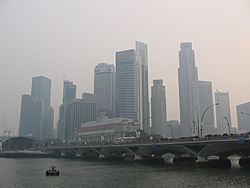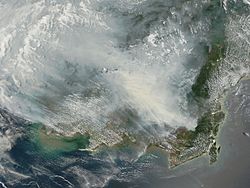ASEAN Agreement on Transboundary Haze Pollution facts for kids
| Type | Environmental protocol |
|---|---|
| Signed | 2002 |
| Signatories |
|
| Depositary | Secretary General of ASEAN |
| Language | English |



The ASEAN Agreement on Transboundary Haze Pollution is an important agreement. It was signed in 2002 by countries in Southeast Asia. Its main goal is to reduce air pollution called haze. This haze often crosses borders between countries.
The agreement states that haze from land and forest fires needs to be stopped. This requires both national efforts and teamwork between countries. By September 2014, all ten ASEAN countries had officially agreed to the treaty.
Contents
Why This Agreement Was Needed
This agreement was created because of a big environmental problem. A severe haze crisis hit Southeast Asia in the late 1990s. This crisis was mostly caused by farmers clearing land. They used open burning on the Indonesian island of Sumatra.
Satellite pictures showed many hot spots. These were in Kalimantan/Borneo, Sumatra, the Malay Peninsula, and other areas. An estimated 45,000 square kilometers of forest and land burned. Countries like Malaysia, Singapore, Thailand, and Brunei were badly affected.
Haze happens almost every year in some ASEAN nations. Dangerous levels of haze usually occur during the dry season. This is from June to September. During this time, southwest monsoon winds blow the haze. It moves from Sumatra, Indonesia, towards the Malay Peninsula and Singapore. This can create thick haze that lasts for weeks.
Countries Involved in the Agreement
This table shows when each country officially joined the agreement:
| Member state | Date of official agreement | Date of official record |
|---|---|---|
| 3 December 2002 | 18 February 2003 | |
| 13 January 2003 | 14 January 2003 | |
| 27 February 2003 | 23 April 2003 | |
| 5 March 2003 | 17 March 2003 | |
| 24 March 2003 | 29 May 2003 | |
| 10 September 2003 | 26 September 2003 | |
| 19 December 2004 | 13 July 2005 | |
| 24 April 2006 | 9 November 2006 | |
| 1 February 2010 | 4 March 2010 | |
| 16 September 2014 | 20 January 2015 |
How the Agreement Works
The agreement is managed by environment ministers. Other representatives from ASEAN countries also help. Their meetings are organized by the ASEAN Socio-Cultural Community Council. This council is one of three main groups under the ASEAN summit.
The treaty asks countries to work together to stop haze. This means monitoring the situation and preventing fires. They aim to do this while also focusing on sustainable development.
What the Agreement Has Achieved
In October 2013, ASEAN leaders approved a system to monitor haze together. This system cost US$100,000. Singapore also offered to work directly with Indonesian farmers. The goal is to encourage farming methods that don't cause haze. This helps solve the problem at its source. Singapore has done this before with farmers in Indonesia's Jambi province.
Challenges and Problems
Indonesia is a main source of the haze. It was the last ASEAN country to officially join the agreement. This happened in 2014, 12 years after it was first signed. There are still worries about Indonesia's ability to control the problem.
The agreement has not stopped the haze from returning every year. Haze came back between 2004 and 2010. It also returned in 2013, 2014, and 2015. Recently, Indonesia has been named the world's third largest emitter of greenhouse gases. About 75% of its emissions come from cutting down forests.
Some people say the "haze treaty" is not clear enough. They also say it lacks ways to make sure countries follow the rules. It also doesn't have strong ways to solve disagreements. However, ASEAN has tried to improve how it works together on this issue. This agreement is legally binding, which is something ASEAN had avoided in the past.
The way ASEAN usually works protects each country's right to act alone. This means countries might focus on their own interests instead of what's best for the whole region. Also, close ties between powerful business people and politicians have made it hard to change things.
In 2014, Singapore passed its own law. It's called the Transboundary Haze Pollution Act. This law punishes those who cause pollution that harms other countries.
See Also
- Southeast Asian haze
- Transboundary Haze Pollution Act 2014


